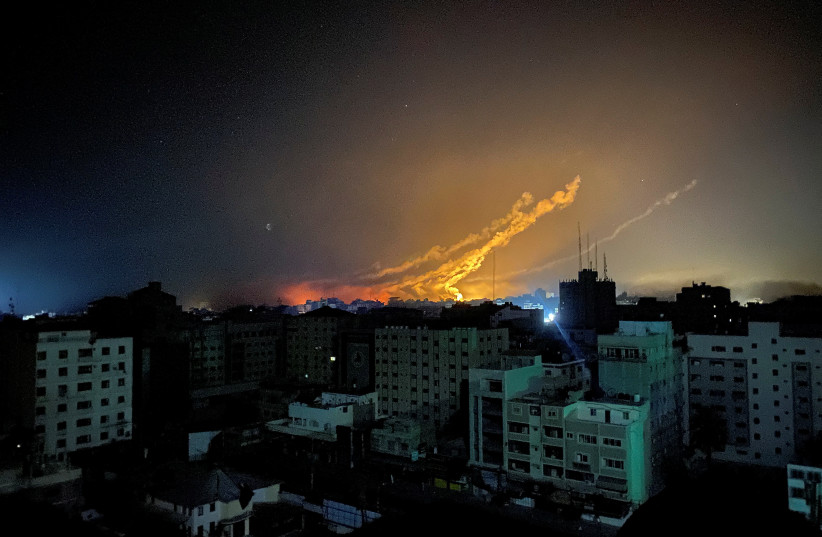As the war with Hamas enters its second month, a strange question arises: Who is the enemy – A city? An organization? A country? A nation? An idea?
It used to be a simple question. The enemy was the Arab world, and its enmity’s fuel was nationalism. The enemy was the Arab world because every Arab government denied Israel’s right to exist and actively fought it, if not militarily, then diplomatically and economically.
That’s not what we face today. With more than 150 million Arabs formally at peace with Israel, this war is not with the Arab world. If anything, many Arab governments detest Hamas and would welcome its decimation. In fact, Israel’s current fighting is not with any state but with three seditious organizations.
In Gaza, Hamas won a legislative election, but it never won a general election. Instead, its goons violently removed the Palestinian Authority’s representatives in 2006 and have since ruled Gaza’s streets.
In Lebanon, Hezbollah was never elected to lead the country. Even so, it has effectively hijacked the Lebanese government, ignored Lebanon’s army, and paralyzed its parliament. Lastly, in Yemen, the Houthis, who have just fired missiles at us from across the Red Sea, are also rebels, insurgents who launched a gruesome civil war in 2004 and seized the capital, Sanaa, in 2014.

The common denominator among these three insurgencies, besides their hostility toward Israel, is that they are driven by religion, and more specifically by Islamist jihadism. Is this, then, the enemy?
THE ARAB challenge to Israel was originally secular. Gamal Abdel Nasser, Hafez Assad, and Saddam Hussein were all secular. Yes, they deployed religious rhetoric, especially against Israel, but domestically they fought Islamism, often violently.
If anything, what we now face is this record’s inversion: religious fanatics citing nationalist concepts in which they don’t believe. Most laughable in this regard is their usage of terms like “resistance,” “occupation,” or “decolonization,” all of which connote one land’s fight for freedom. In fact, they are part of an effort to impose their faith on the whole world and eradicate the freedom they claim to hail.
The jihadist scourge is not local. It’s global. It has stuck everywhere, from London, Paris, and New York to Bali, Mumbai, and Sharm el-Sheikh. So yes, morally speaking, the enemy we face is jihadism, for which Israeli Jewry is a version of the warm-up act that German Jewry was for Nazism while it prepared for World War II. If it’s up to the jihadists, the Black Sabbath massacre will be recalled as Kristallnacht’s sequel.
The ultimate enemy is in Iran
Jihadism, then, is the moral engine that drives the people fighting us these days from their foxholes in Gaza, Lebanon, and Yemen. Even so, the ultimate enemy we face nests not in Gaza, Beirut, or Sanaa but in Tehran.
THE ENEMY’S transformation took a while to notice, not only because its cause shifted from nationalism to religion but also because its ethnicity shifted, from Arab to Persian.
The new enemy’s transfiguration became even trickier to notice because it was careful to deploy non-Iranians wherever it kindled its revolution’s fires. In some cases, Tehran deployed Arab Shi’ites. That’s what happened in Iraq and Lebanon.
In others, they harnessed Arabs with looser affiliations to Shi’ism. That’s what happened with Syria’s Alawites and Yemen’s Houthis. And in some cases, they inspired Arab Sunnis. That’s what happened in Gaza.
Strategically, all this is academic. What matters is that all the violence we now face has a clear source, not only ideologically and spiritually but also financially and militarily.
The extent to which Iran has been directly involved in the Black Sabbath massacre has yet to be established. Intuitively, millions of Israelis, as well as many elsewhere, especially in foreign intelligence services, assume Iran was involved, at least in conceiving and planning the slaughter, and in training and equipping its perpetrators.
But even in the unlikely event that Iran played no role at all in this atrocity, it had enough of a role elsewhere. Hezbollah’s artillery barrages are clearly ordered from Iran, and clearly an act of war, as are the Yemeni shots. The casus belli that sparked the 1967 Six Day War – Egypt’s blockading of the Red Sea – was less flagrant than firing rockets into Israelis’ living rooms. This is besides Tehran’s enthusiastic applause of the Black Sabbath massacre.
It follows that whatever the aftermath of the fighting in Gaza, Iran emerges from this cataclysm as an active aggressor toward the Jewish state, and also of the Jewish people, as Tehran openly and consistently denies the Jews’ right to their ancestral land, in addition to having assaulted Jewish communities abroad.
What this implies in terms of action is a separate discussion, one which had best be conducted in arenas less public than a newspaper. Two principles, however, should be said publicly. The first is that, unlike Arab nationalism, Iranian fundamentalism threatens not only Israel, and not only the Middle East, but the entire world.
The second is that the enemy, as argued here in the past (“Don’t bomb Tehran,” November 4, 2011), is not the Iranian people. The enemy is the Iranian regime; the ayatollahs and mullahs who have let our blood.
The Iranian nation, by contrast, was Israel’s friend for three decades. We Jews don’t forget such things, just like we don’t forget Cyrus, the Persian king who restored the Land of Israel to the Jews; just like we don’t forget Haman, the Persian minister who sought “to destroy, kill, and annihilate all the Jews, young and old, women and children”; just like we don’t forget how that man of hatred ended up hanged on the very gallows he had built for the first man in any literature to be called “the Jew.”
www.MiddleIsrael.net
The writer, a Hartman Institute fellow, is the author of the bestselling Mitzad Ha’ivelet Ha’yehudi (The Jewish March of Folly, Yediot Sefarim, 2019), a revisionist history of the Jewish people’s political leadership.
